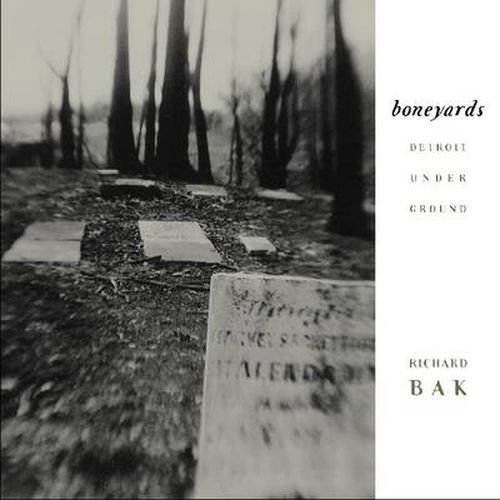Readings Newsletter
Become a Readings Member to make your shopping experience even easier.
Sign in or sign up for free!
You’re not far away from qualifying for FREE standard shipping within Australia
You’ve qualified for FREE standard shipping within Australia
The cart is loading…






From the earliest burial mounds to today’s simple street shrines, Boneyards: Detroit Under Ground reveals how Metro Detroiters have interred their dead and honored their memory. Author Richard Bak investigates the history of dozens of local cemeteries and also explores the cultural and business side of dying, from old-fashioned home funerals to the grave-robbing resurrectionists of the nineteenth century to modern funeral directors. Bak presents a mix of historic and contemporary photographs to illustrate each site or event alongside lively prose descriptions. Taken together, Bak’s informative and often surprising historical snapshots span the entire metro area and three centuries of history. Boneyards visits the area’s largest cemeteries-including Elmwood, Woodmere, Mount Olivet, Mount Elliott-and showcases some of their most intricate and unusual monuments. Bak also introduces readers to abandoned graveyards like William Ganong Cemetery in Westland, Millar Cemetery in Clinton Township, and Beth Olem Cemetery inside the GM Poletown Plant. Bak includes photos of some of the city’s largest funerals, from those of automaker Henry Ford and orchestra conductor Ossip Gabrilovitch to civil rights icon Rosa Parks and rapper DeShaun Proof Holton. In addition, Bak tells the stories of the ordinary and the unclaimed in local cemeteries, along with the social changes like the creation of a drive-through funeral home in the 1970s, the white flight of interred family members from Detroit cemeteries, and the trend of local cemeteries adding graves that face Mecca to accommodate the growing Muslim population. Ultimately, Bak proves that our treatment of the dead reveals much about our culture and our values. Boneyards will be intriguing reading for Detroit historians, local residents, and anyone interested in the customs of memorializing past generations.
$9.00 standard shipping within Australia
FREE standard shipping within Australia for orders over $100.00
Express & International shipping calculated at checkout
From the earliest burial mounds to today’s simple street shrines, Boneyards: Detroit Under Ground reveals how Metro Detroiters have interred their dead and honored their memory. Author Richard Bak investigates the history of dozens of local cemeteries and also explores the cultural and business side of dying, from old-fashioned home funerals to the grave-robbing resurrectionists of the nineteenth century to modern funeral directors. Bak presents a mix of historic and contemporary photographs to illustrate each site or event alongside lively prose descriptions. Taken together, Bak’s informative and often surprising historical snapshots span the entire metro area and three centuries of history. Boneyards visits the area’s largest cemeteries-including Elmwood, Woodmere, Mount Olivet, Mount Elliott-and showcases some of their most intricate and unusual monuments. Bak also introduces readers to abandoned graveyards like William Ganong Cemetery in Westland, Millar Cemetery in Clinton Township, and Beth Olem Cemetery inside the GM Poletown Plant. Bak includes photos of some of the city’s largest funerals, from those of automaker Henry Ford and orchestra conductor Ossip Gabrilovitch to civil rights icon Rosa Parks and rapper DeShaun Proof Holton. In addition, Bak tells the stories of the ordinary and the unclaimed in local cemeteries, along with the social changes like the creation of a drive-through funeral home in the 1970s, the white flight of interred family members from Detroit cemeteries, and the trend of local cemeteries adding graves that face Mecca to accommodate the growing Muslim population. Ultimately, Bak proves that our treatment of the dead reveals much about our culture and our values. Boneyards will be intriguing reading for Detroit historians, local residents, and anyone interested in the customs of memorializing past generations.